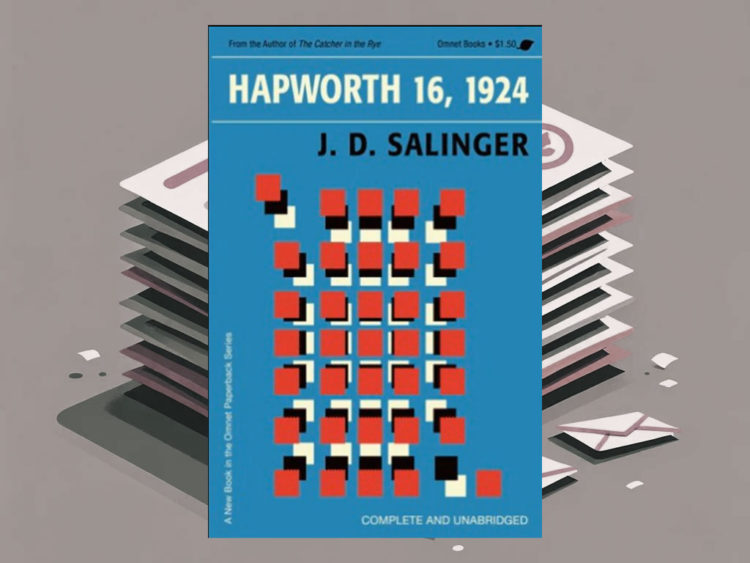“Hapworth 16, 1924” is a short story by J.D. Salinger that was published in The New Yorker in 1965. It is notable for being Salinger’s last published work before he became reclusive and stopped publishing altogether. The story is presented as a letter from seven-year-old Seymour Glass, one of the Glass family siblings who frequently appear in Salinger’s works, including “Franny and Zooey”.
Short Summary
“Hapworth 16, 1924” is presented as a letter written by a seven-year-old Seymour Glass while he’s at Camp Simon Hapworth. Despite his young age, Seymour’s letter is highly sophisticated and covers an array of topics—from detailed accounts of camp life to philosophical musings. He critiques the camp staff and his fellow campers, often with biting wit. Seymour also delves into spirituality, literature, and his own prodigious intellect. The letter even includes a lengthy list of books he wishes his family to send him, showcasing his advanced reading level. The narrative offers deep insight into Seymour’s precocious mind, setting the stage for the complex character he becomes in Salinger’s later works.
Comprehensive Synopsis of “Hapworth 16, 1924”
Introduction of the Letter
The story begins with a letter from seven-year-old Seymour Glass, who is spending time at Camp Simon Hapworth. Despite his young age, the letter is remarkably complex and verbose.
Camp Life and Observations
Seymour provides detailed accounts of his daily life at camp. He describes the activities, the campers, and the staff, often critiquing them with a level of insight and wit that far surpasses his age.
Intellectual and Spiritual Musings
Interwoven with descriptions of camp life are Seymour’s reflections on various intellectual and spiritual matters. He discusses literature, philosophy, and even different religious concepts, indicating a grasp of subjects that are unusually advanced for his age.
The Book List
Seymour includes a long list of books that he wishes his family to send him. The list features a range of high-brow, adult literature, further demonstrating his precocious intellectual abilities.
Personal Reflections and Family
In addition to his observations and requests, Seymour also spends time reflecting on his family, particularly his relationship with his siblings. These reflections add a layer of emotional complexity to the character.
Conclusion and Foreshadowing
The letter concludes with Seymour alluding to his own complex inner life and future trajectory. Although he does not explicitly state it, the tone suggests that Seymour is already grappling with the existential questions that will come to define him in Salinger’s later works.
Interesting Facts
1. Last Published Work: This story is noteworthy for being Salinger’s last published work before he retreated from public life.
2. Complex Protagonist: Seymour Glass, the story’s protagonist, is just seven years old but exhibits intellectual and spiritual capacities that far exceed his age.
3. Publication History: Despite its significance, “Hapworth 16, 1924” has never been included in any of Salinger’s short story collections. It remains accessible mainly through its original publication in The New Yorker.
4. Controversial Reception: The story has polarized critics and readers alike, with some praising its depth while others criticize its verbosity and complexity.
5. Almost Republished: In 1997, there were plans to republish the story as a standalone book, but this was abruptly canceled for reasons that remain unclear.
6. Connection to Other Works: The character of Seymour Glass appears in other Salinger stories, most notably “A Perfect Day for Bananafish”, providing a multi-layered view of this complex character.
7. Literary Technique: The entire story is written in epistolary form, presented as a letter from Seymour to his family.
8. Themes: The story delves into themes that Salinger revisited throughout his career, such as the search for spiritual enlightenment and the complexities of child prodigies.
9. Cult Following: Due to its inaccessibility and complex themes, “Hapworth 16, 1924” has developed a cult following among Salinger enthusiasts.
10. Unfinished Business: Salinger reportedly continued writing until his death in 2010, but whether he ever revisited the characters or themes from “Hapworth” remains a subject of speculation.
Frequently Asked Questions About “Hapworth 16, 1924”
Why is this story so different from Salinger’s other works?
“Hapworth 16, 1924” is unique due to its epistolary form and the extraordinarily complex intellectual and spiritual musings of its seven-year-old protagonist, Seymour Glass. It delves deeper into existential and spiritual themes compared to some of Salinger’s more accessible works.
Why was “Hapworth 16, 1924” never included in any of Salinger’s collections?
The reasons for this omission are not entirely clear. Salinger was known for being very private and particular about his work, and it’s possible that he had specific intentions for this story that precluded its inclusion in broader collections.
Why was the 1997 republication of the story canceled?
The cancellation remains a subject of speculation. Given Salinger’s reclusive nature and strict control over his works, it’s possible that he himself decided against the republication.
Is Seymour Glass a self-insert for J.D. Salinger?
While it’s tempting to see parallels between Seymour’s intellectual and spiritual pursuits and Salinger’s own, there’s no definitive evidence to suggest that Seymour is a direct self-insert for the author.
How does this story fit into the larger Glass family saga?
“Hapworth 16, 1924” provides valuable insights into Seymour Glass, who is a pivotal character in the Glass family stories. The letter he writes in this story serves as a foundation for understanding his complex character in Salinger’s other works.
What themes does the story explore?
The story grapples with themes of existentialism, spirituality, intellectualism, and the complexities of prodigious talent, consistent with the themes Salinger explores in his other works.
Why does the story have such a polarizing effect on readers and critics?
The story’s complexity, verbosity, and the advanced intellectual and spiritual discourse presented through a child character have led to divided opinions. Some find it a rich, layered narrative, while others see it as pretentious or inaccessible.
🤔📖 Time to Weigh In, Folks! 📖🤔
Is Salinger a literary wizard who’s masterfully woven the complexities of youth and spirituality? Or is he a pompous over-thinker, hiding behind the guise of a seven-year-old genius? Hit the comment section and unleash your most unfiltered opinions! Let the intellectual brawl begin! 🥊💥

Comments